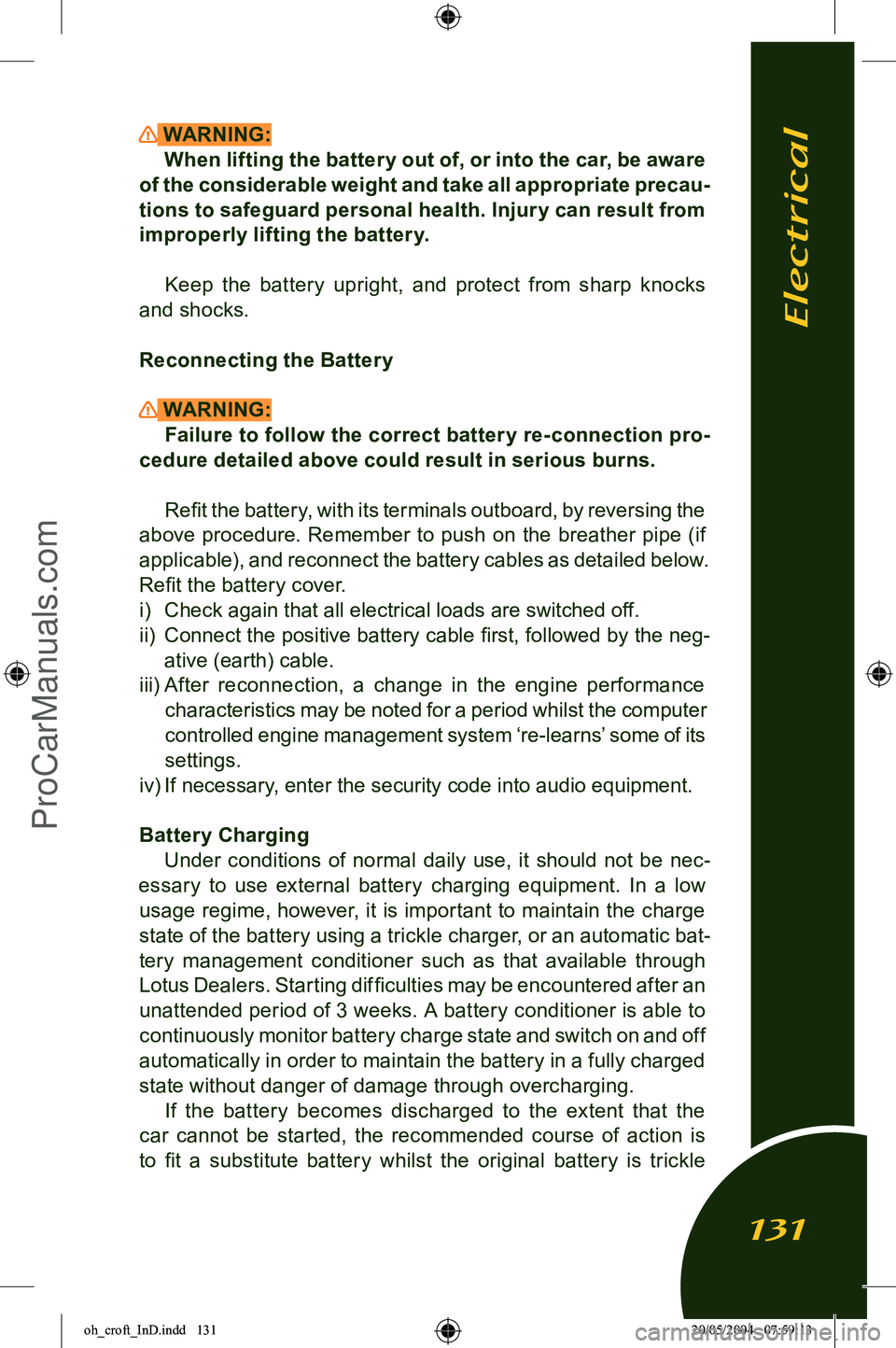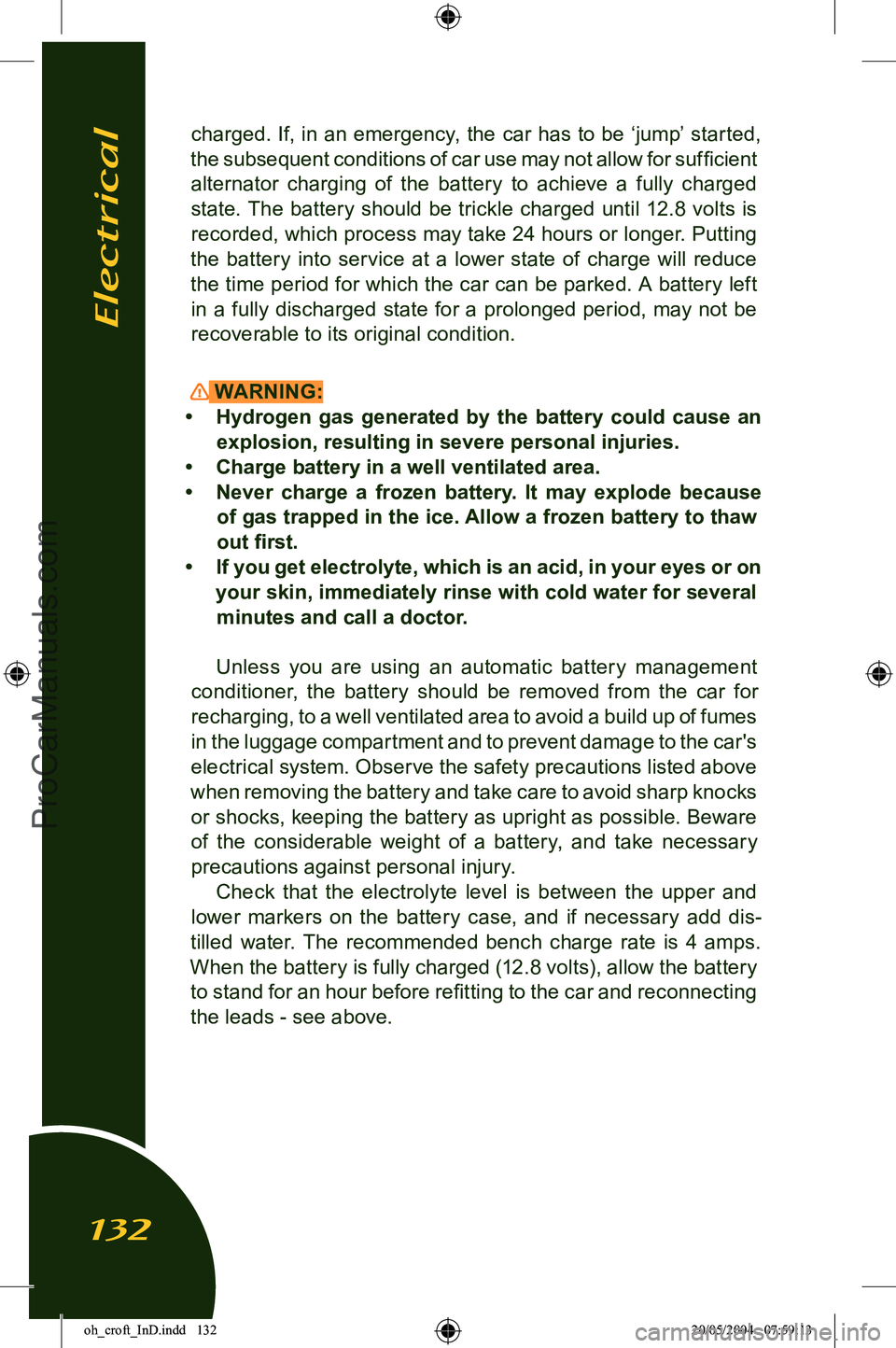automatic LOTUS ELISE 2005 User Guide
[x] Cancel search | Manufacturer: LOTUS, Model Year: 2005, Model line: ELISE, Model: LOTUS ELISE 2005Pages: 205, PDF Size: 4.51 MB
Page 133 of 205

WARNING:When lifting the battery out of, or into the car, be aware
of the considerable weight and take all appropriate precau
-
tions to safeguard personal health. Injury can result from improperly lifting the battery.
Keep the battery upright, and protect from sharp knocks
and shocks.
Reconnecting the Battery
WARNING: Failure to follow the correct battery re- connection pro
-
cedure detailed above could result in serious burns.
Refit the battery, with its terminals outboard, by reversing the
above procedure. Remember to push on the breather pipe (if
applicable), and reconnect the battery cables as detailed below.
Refit the battery cover.
i) Check again that all electrical loads are switched off.
ii) Connect the positive battery cable first, followed by the neg
-
ative (earth) cable.
iii) After reconnection, a change in the engine performance
characteristics may be noted for a period whilst the computer
controlled engine management system ‘re-learns’ some of its
settings.
iv) If necessary, enter the security code into audio equipment.
Battery Charging Under conditions of normal daily use, it should not be nec
-
essary to use external battery charging equipment. In a low usage regime, however, it is important to maintain the charge
state of the battery using a trickle charger, or an automatic bat
-
tery management conditioner such as that available through Lotus Dealers. Starting difficulties may be encountered after an
unattended period of 3 weeks. A battery conditioner is able to continuously monitor battery charge state and switch on and off automatically in order to maintain the battery in a fully charged
state without danger of damage through overcharging.
If the battery becomes discharged to the extent that the
car cannot be started, the recommended course of action is
to fit a substitute battery whilst the original battery is trickle
Electrical
131
oh_croft_InD.indd 13120/05/2004 07:59:13ProCarManuals.com
Page 134 of 205

charged. If, in an emergency, the car has to be ‘jump’ started,
the subsequent conditions of car use may not allow for sufficient alternator charging of the battery to achieve a fully charged
state. The battery should be trickle charged until 12.8 volts is recorded, which process may take 24 hours or longer. Putting
the battery into service at a lower state of charge will reduce
the time period for which the car can be parked. A battery left
in a fully discharged state for a prolonged period, may not be recoverable to its original condition.
WARNING:
• Hydrogen gas generated by the battery could cause an explosion, resulting in severe personal injuries.
• Charge battery in a well ventilated area.
• Never charge a frozen battery. It may explode because of gas trapped in the ice. Allow a frozen battery to thaw
out first.
• If you get electrolyte, which is an acid, in your eyes or on your skin, immediately rinse with cold water for several minutes and call a doctor.
Unless you are using an automatic batter y management
conditioner, the battery should be removed from the car for
recharging, to a well ventilated area to avoid a build up of fumes
in the luggage compartment and to prevent damage to the car's
electrical system. Observe the safety precautions listed above
when removing the battery and take care to avoid sharp knocks
or shocks, keeping the battery as upright as possible. Beware
of the considerable weight of a battery, and take necessary precautions against personal injury. Check that the electrolyte level is between the upper and
lower markers on the battery case, and if necessary add dis
-
tilled water. The recommended bench charge rate is 4 amps.
When the battery is fully charged (12.8 volts), allow the battery
to stand for an hour before refitting to the car and reconnecting
the leads - see above.
Electrical
132
oh_croft_InD.indd 13220/05/2004 07:59:13ProCarManuals.com
Page 168 of 205

lision, fire, theft or climatic conditions are not covered under
this warranty.
(f) ODOMETER ALTERATION.
Warranty coverages do not apply if the odometer has stopped,
been altered or the car’s correct mileage cannot accurately
and easily be determined.
(g) This Limited Warranty excludes
the emission control
system, the Federal and California warranties for which are
detailed on pages 171 through 187.
(h) Malfunctions, defects or damage caused by
any non-
Lotus part or accessory
are not covered by this warranty. If
a part which is covered by the Limited Warranty fails during
the warranty period and in turn this failure causes a failure of
a non-warranted part, then Lotus will consider replacing the
non-warranted part.
(j) If any after-market sport parts are fitted to your car, such parts are not covered by the Limited Warranty. Such parts
are covered by any warranty which accompanies the sale of
that particular part. Defects arising from track use will not be covered by your Limited Warranty. Any original part affected
or damaged by the fitment of any off road or track part may
not be covered by your Limited Warranty.
k) Minor wind noise and minor water ingress from the hard or
soft top roofs.
NOTICE: The car is a speciality sports car not intended to go
through automatic car washes. If the car is taken through a
car wash any damage is not covered by the warranty.
l) If it is determined that paint on the car must be repaired because of an item covered under warranty the paint colour
matching of repaired or replaced body panels will be achieved
within practicable limits as determined by the Company. Paint
-
ing of the entire car solely for the purpose of paint colour matching will not be covered under the warranty.
m) Noise and vibration are a normal and necessary feature of a mechanical device such as a motor car. The nature and
Limited Warranty
166
oh_croft_InD.indd 16620/05/2004 07:59:21ProCarManuals.com